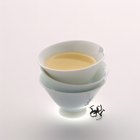
Cornstarch effectively thickens most soups, sauces and gravies, but you get the most out of it when you use it in milk- or cream-based soups and sauces -- because it doesn't add any flavor or color of its own. Unlike roux, which needs to be cooked with fat to gelatinize the starch, cornstarch thickens by forming a gel in water when it reaches boiling temperature. Cornstarch only needs to be cooked for one minute after you add it, so you don't have to worry about the sauce curdling.
Step 1
Add about 1 tablespoon of cornstarch to a bowl for every cup of cream sauce you want to thicken. Add about half as much cold water to the cornstarch and whisk vigorously until a paste, or slurry, forms, then place it in the refrigerator. Mixing the starch well with the cold water prevents clumps from forming when you add it to the sauce.
Step 2
Cook the cream sauce and season it to taste. Bring the sauce to a simmer on the stove. The sauce needs to be around 180 degrees Fahrenheit, or close to a full boil, to quickly activate the thickening properties of the cornstarch after you incorporate it.
Step 3
Take the slurry out of the refrigerator and stir it a couple of times. Add the slurry to the cream sauce 1/2 to 1 tablespoon at a time while constantly whisking. Incorporate the starch completely each time before adding more. Cornstarch thickens more evenly and uniformly when added in portions instead of all at once.
Step 4
Raise the heat so the sauce reaches a full boil, and cook it for one minute without stirring. Take the saucepan off the burner and vigorously whisk to lower the heat after boiling. Time the one minute of boiling because every second longer it boils, the greater the chances of the cornstarch bonds breaking.
Step 5
Check the consistency by inserting a spoon in the sauce and turning it upside down. A thickened cream sauce should coat the spoon without dripping off immediately.
Step 6
Stir in warm heavy cream until the sauce reaches the desired color and texture. Serve the sauce as soon as possible. Although cornstarch is one of the most stable thickening agents, it does degrade over time, so the cream sauce is at its apex of quality and viscosity right after finishing it with warm cream.
Related Articles

How to Substitute Potato Starch for ...

How to Thicken Cream Filling

How to Get Half & Half to Thicken

What Is Ratio for Cornstarch & Water to ...

How to Thicken Creamed Corn

How to Fix Runny Boston Cream Filling

How to Dissolve Cooking Flour

How to Thicken Stew With Flour

How Much Flour to Thicken a Sauce?

How to Improve Jar Spaghetti Sauce With ...

How to Substitute Cornstarch for ...

How to Cook Luglug Cornstarch Noodles

Substitute for Vanilla Custard Powder

How to Make & Freeze Homemade Spaghetti ...

How to Cook Cubed Steak With Gravy and ...

How to Make Whipped Frosting Without ...

How to Freeze Marinara Sauces

Why Does a Sauce Curdle?

Can You Use Half & Half Instead of ...

How Many Calories Are in Cream of Wheat?
References
Warnings
- Don't boil the cream sauce for more than one minute after you add it.
Writer Bio
A.J. Andrews' work has appeared in Food and Wine, Fricote and "BBC Good Food." He lives in Europe where he bakes with wild yeast, milks goats for cheese and prepares for the Court of Master Sommeliers level II exam. Andrews received formal training at Le Cordon Bleu.
Photo Credits
Jupiterimages/Photos.com/Getty Images